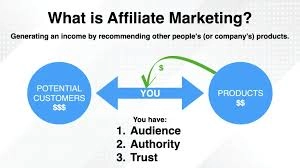Learn how to make money online through affiliate marketing with proven strategies and tips for beginners. is one of the most popular ways to make money online. It’s a flexible method that allows you to earn income by promoting products or services from various companies, without needing to create your products. With the right approach, you can start earning a passive income that can grow over time. This guide will walk you through everything you need to know about making money online through affiliate marketing, from choosing a niche to scaling up your efforts.
What is Affiliate Marketing?

Affiliate marketing is a performance-based marketing model where you earn commissions by promoting other people’s products or services. You sign up with an affiliate program, get a unique link (known as an affiliate link), and when someone purchases through your link, you receive a commission.
Many large and small companies offer affiliate programs, including Amazon, Flipkart, and digital platforms like ClickBank. It’s a win-win situation: companies increase their sales through affiliates, and affiliates (like you) earn a commission for every successful sale.
Why Choose Affiliate Marketing to Make Money Online?
Affiliate marketing offers several benefits that make it an ideal choice for making money online:
- Low startup cost: No need to invest in creating or managing a product.
- Passive income potential: You can earn while you sleep, as users purchase products through your affiliate links.
- Flexible work environment: You can do it from anywhere, with minimal equipment—a laptop and internet connection are enough.
- Multiple niches to explore: From tech to health, finance, and lifestyle, you can pick a niche you’re interested in.
With the global e-commerce industry expanding, there’s enormous potential in affiliate marketing.
Step 1: Selecting a Profitable Niche
Choosing the right niche is crucial. A niche is a specific topic or area in which you will focus your affiliate marketing efforts. Popular niches include health and fitness, personal finance, travel, and technology.
Tips for Choosing a Niche
- Passion and Knowledge: Choose a topic you’re genuinely interested in. Being passionate about the niche will make creating content easier and more enjoyable.
- Demand and Interest: Use tools like Google Trends, Ahrefs, and Ubersuggest to research search volumes and trends. This will help you gauge the demand for your niche.
- Monetization Potential: Check if there are enough affiliate programs and products in your niche that offer a reasonable commission rate.
For example, if you’re interested in fitness, there are numerous products like supplements, workout gear, and online courses that you can promote as an affiliate.
Step 2: Finding the Right Affiliate Programs
Once you’ve chosen your niche, the next step is to find affiliate programs that align with it. Most affiliate programs fall under one of two types:
- Company-specific programs: Many companies run their affiliate programs, such as Amazon Associates and Flipkart Affiliate.
- Affiliate networks: Networks like ClickBank, ShareASale, and Commission Junction offer access to a variety of affiliate programs in different niches.
Popular Affiliate Programs for Beginners
- Amazon Associates: Amazon’s affiliate program is widely used and has a huge range of products, but the commission rates are relatively low.
- ClickBank: A digital product platform with higher commission rates.
- CJ Affiliate (Commission Junction): Offers a mix of digital and physical products, with various brands and companies on the platform.
- ShareASale: Popular for a wide range of products and a user-friendly platform.
When evaluating programs, consider factors like the commission rate, payment terms, and cookie duration (how long a user’s click remains valid for commission). For instance, Amazon offers a 24-hour cookie duration, while other programs offer longer durations, which can result in more earnings.
Step 3: Creating High-Quality Content

Creating quality content is the heart of successful affiliate marketing. High-quality content can attract and engage your audience, build trust, and drive clicks on your affiliate links.
Types of Content That Work Well for Affiliate Marketing
- Product Reviews: Writing detailed, honest product reviews can help readers make purchase decisions. Reviews are effective because they target users who are already in the consideration stage.
- Comparison Articles: Comparisons between two or more similar products allow readers to weigh the pros and cons and decide what works best for them.
- Listicles: Articles like “Top 10 Fitness Gadgets” are popular because they provide value to readers by highlighting multiple options.
- How-to Guides and Tutorials: Detailed guides or tutorials with affiliate product recommendations can drive conversions. For instance, a “how-to” guide on setting up a home gym can include affiliate links for equipment.
- Email Newsletters: Email marketing is another way to share affiliate links with engaged subscribers. You can include reviews, recommendations, and tips.
When creating content, aim to provide value rather than just pushing products. Offer insights and genuinely helpful information so that readers trust your recommendations.
Step 4: Driving Traffic to Your Content
To make money with affiliate marketing, you need traffic—visitors who are genuinely interested in the products you’re promoting. There are two primary ways to drive traffic: organic and paid.
Organic Traffic Strategies
- SEO (Search Engine Optimization): Optimizing your content for search engines is a long-term traffic strategy. Use relevant keywords, optimize meta descriptions, and ensure your website is mobile-friendly.
- Social Media Marketing: Platforms like Instagram, Pinterest, and Twitter are great for sharing affiliate content. Visual content works especially well on social media.
- Email Marketing: Building an email list gives you a direct line of communication with your audience. Send regular newsletters or updates with helpful content and affiliate links.
- YouTube Channel: Video content is increasingly popular. A YouTube channel with product reviews, tutorials, and recommendations can attract a large audience.
Paid Traffic Strategies
- Pay-Per-Click (PPC) Advertising: Platforms like Google Ads or Bing Ads allow you to display ads based on specific keywords.
- Social Media Ads: Facebook and Instagram ads can be effective for targeting specific demographics or interests related to your niche.
- Sponsored Content: Partner with other bloggers or social media influencers to promote your affiliate content.
For beginners, it’s often best to start with organic traffic and then gradually explore paid options as you become more confident and see what works best.
Step 5: Analyzing and Optimizing Your Affiliate Marketing Efforts

Analyzing your results is essential to improving and scaling your affiliate marketing business. Use analytics tools to track clicks, conversions, and sales for each affiliate link.
Key Metrics to Monitor
- Click-through rate (CTR): The percentage of people who click your affiliate link after seeing it.
- Conversion rate: The percentage of people who purchase after clicking your link.
- Average order value (AOV): This metric shows how much the average buyer spends through your affiliate links.
- Return on investment (ROI): Important if you’re using paid advertising.
Using tools like Google Analytics, you can set up goals and conversion tracking to monitor how effective each piece of content is. Additionally, most affiliate programs provide dashboards that show data specific to your links.
Regularly reviewing these metrics helps you understand what type of content or promotion strategy works best. You can then optimize underperforming content or scale up on successful strategies.
Scaling Your Affiliate Marketing Business
Once you’ve found some success with affiliate marketing, the next step is to scale your efforts for even higher returns.
Ways to Scale Your Affiliate Marketing
- Expanding Content Variety: Introduce new content formats such as e-books, webinars, or podcasts to reach a broader audience.
- Building a Brand: Establishing a strong brand can make your affiliate business more trustworthy. Consider creating a professional website, with consistent branding, and a recognizable logo.
- Outsourcing Tasks: As your affiliate income grows, you might consider outsourcing tasks like content creation, design, or SEO.
- Joining Higher-Paying Affiliate Programs: Once you have a solid audience, you might qualify for exclusive or high-paying affiliate programs.
- Creating Your Own Digital Product: Some affiliate marketers branch into selling their own digital products, like courses or e-books, which can complement affiliate products.
With consistent effort and smart scaling strategies, you can turn affiliate marketing into a sustainable source of income.
Conclusion
Affiliate marketing offers an exciting opportunity to make money online, and it’s accessible to anyone willing to put in the effort. By following the steps outlined in this guide—choosing a profitable niche, joining the right programs, creating high-quality content, driving traffic, and analyzing your performance—you can set yourself up for success. For more information please get in touch